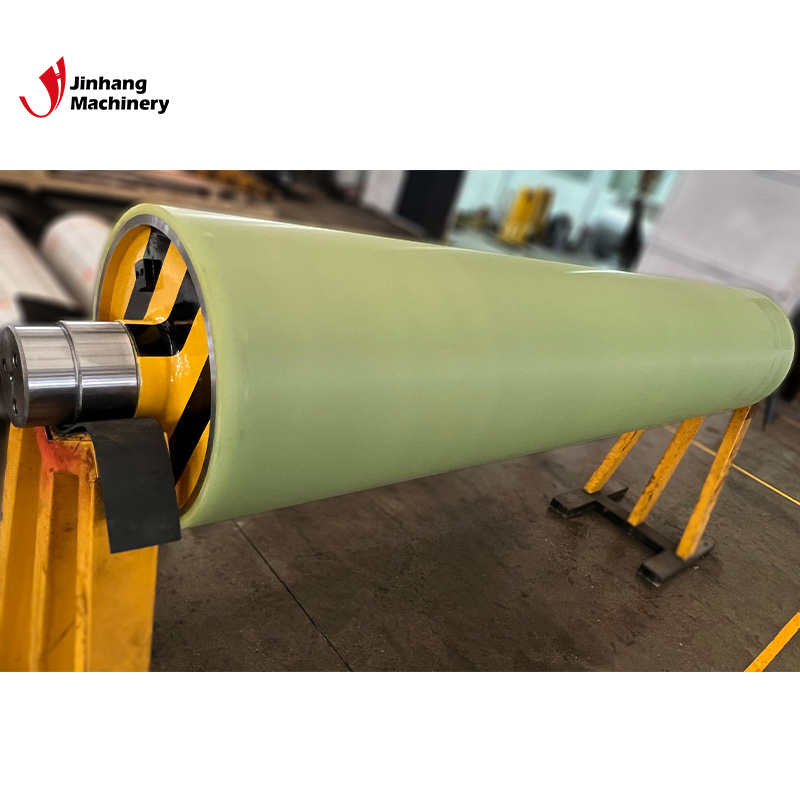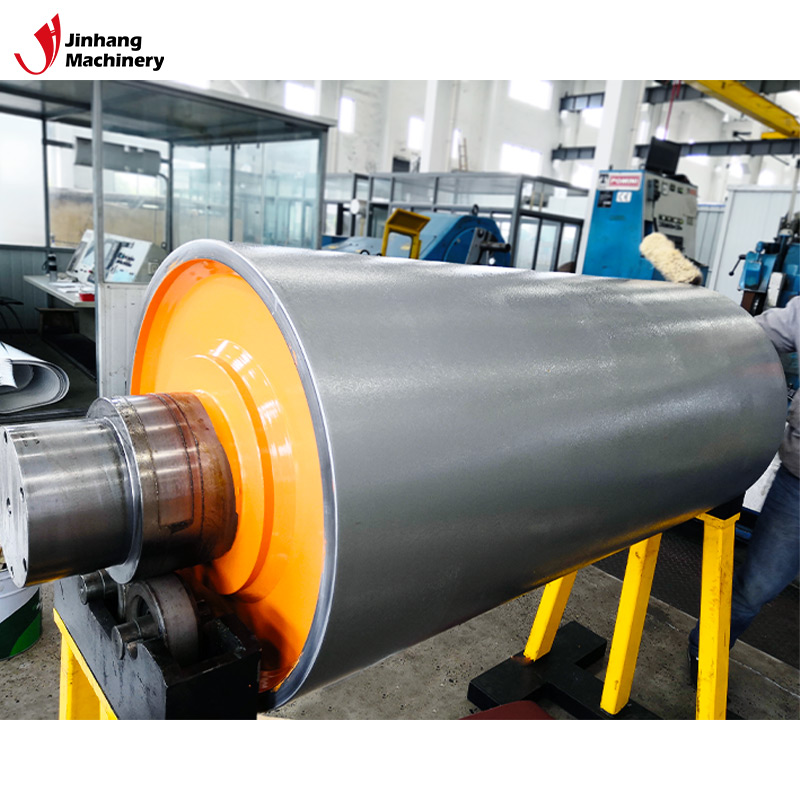What is the hardness of a Lamination Rubber Roller?
In modern industrial manufacturing, lamination technology is widely used in electronics, printing, packaging, textiles and other industries, and Lamination Rubber Roller, as a key component, plays an indispensable role.
This article will explore the definition, application, characteristics and hardness requirements of Lamination Rubber Roller in depth to help readers better understand the specific functions of this important equipment and its performance in different applications.

What is a Lamination Rubber Roller?
Lamination Rubber Roller is a rubber roller used in lamination process, usually composed of a high-strength metal core and a rubber layer coated on it. Its main function is to firmly combine two or more materials by applying uniform pressure and temperature in the lamination process. Lamination Rubber Roller is widely used in the manufacture of electronic circuit boards, the lamination of cardboard and film, the lamination of textile materials and other fields.
The core function of Lamination Rubber Roller is to provide uniform and stable pressure during the lamination process to ensure that different materials can fit closely together to form a strong composite structure. In addition, the elasticity and wear resistance of the rubber roller surface can effectively prevent the material from being damaged during the lamination process, ensuring the quality of the final product.
What are the application areas of laminating rubber rollers?
The application range of laminating rubber rollers is extremely wide, covering from traditional printing and packaging industries to high-tech electronics and textile fields. Here are some of the main application scenarios:
Electronics industry
In the electronics industry, laminating rubber rollers are widely used in the manufacturing process of printed circuit boards (PCBs). In the production of multi-layer circuit boards, laminating rubber rollers press different layers of circuit board materials together by applying uniform pressure to ensure the structural stability and good conductivity of the circuit board. In addition, laminating rubber rollers can also be used in the lamination manufacturing process of precision electronic devices such as liquid crystal displays (LCDs) and organic light-emitting diodes (OLEDs) to ensure the flatness and sealing of the products.
Printing industry
In the printing industry, laminating rubber rollers are used in the composite process of paper, cardboard and plastic film. Through the action of laminating rubber rollers, printed materials can be closely fitted to form a composite material with high strength and excellent visual effects, which is widely used in the manufacture of books, packaging boxes and billboards.
Packaging industry
In the packaging industry, laminating rubber rollers are used to produce multi-layer composite materials, such as paper-plastic composites, aluminum-plastic composites, etc. Through the lamination process, the packaging material not only has good physical properties, but also can achieve special functions such as waterproof, oil-proof, and moisture-proof, which improves the overall performance and market competitiveness of the packaging products.
Textile industry
In the textile industry, laminating rubber rollers are used for the lamination and lamination process of fabrics, non-woven fabrics, and composite fabrics. Through the lamination process, textile materials can obtain higher strength and durability, while also achieving special functions such as waterproof, breathable, and antibacterial, and are widely used in the manufacture of outdoor sportswear, medical textiles, and industrial fabrics.

What are the characteristics of laminating rubber rollers?
As an important equipment in industrial manufacturing, the performance of laminating rubber rollers directly affects production efficiency and product quality. The following are some of the main characteristics of laminating rubber rollers:
Heat resistance
Laminating rubber rollers usually need to work in high temperature environments, especially during the lamination process, the temperature often reaches above 100°C. Therefore, the laminating rubber roller must have good heat resistance to ensure that it can still maintain stable performance under high temperature conditions without deformation or aging.
Wear resistance
During the lamination process, the laminating rubber roller needs to frequently contact with different materials and is susceptible to wear. Therefore, the rubber layer of the laminating rubber roller must have excellent wear resistance to extend its service life and reduce the frequency of replacement and maintenance costs.
Elasticity and hardness
The elasticity and hardness of the laminating rubber roller directly affect the effect of the lamination process. Appropriate elasticity can ensure that the rubber roller can apply pressure evenly and adapt to the shape of different materials during the lamination process. The appropriate hardness can prevent the material from being crushed or deformed while providing sufficient pressure.
Chemical stability
During the operation, the laminating rubber roller may be exposed to various chemicals, such as adhesives, solvents, inks, etc. Therefore, the rubber roller needs to have good chemical stability, be able to resist the erosion of these chemicals, and keep its physical properties unaffected.
What is the hardness of the laminating rubber roller?
The hardness of the rubber roller is an important indicator to measure its performance, usually expressed in Shore A hardness. The hardness of the laminating rubber roller is usually between 20 and 90 Shore A hardness. Rubber rollers of different hardness are selected according to specific application requirements and working environment.
Low hardness (20-40 Shore A hardness)
Low hardness rubber rollers have high elasticity and are suitable for lamination processes that require high material surface requirements and gentle pressure. For example, for materials that are easy to deform, such as films and paper, low hardness rubber rollers are usually used to ensure that the materials will not be damaged during the lamination process.
Medium hardness (40-70 Shore A hardness)
Medium hardness rubber rollers are the most commonly used hardness range and are suitable for most lamination processes. This type of rubber roller can provide sufficient pressure to ensure a close fit between materials, and has a certain elasticity to adapt to the shape changes of materials. It is suitable for the lamination of various cardboard, plastic, and textile materials.
High hardness (70-90 Shore A hardness)
High hardness rubber rollers have less elasticity and are suitable for lamination processes that require greater pressure, such as the lamination of materials such as metal foil and hard plastic. High hardness rubber rollers can provide higher pressure and stability to ensure a firm bond between materials.

Selection and application of lamination rubber rollers
In practical applications, choosing a suitable lamination rubber roller is the key to ensuring production efficiency and product quality. Different materials have different requirements for the hardness of rubber rollers. For materials that are easily deformed or fragile, it is recommended to choose a rubber roller with low hardness; for materials that are hard or require high-pressure lamination, a rubber roller with high hardness should be selected.
Secondly, different lamination processes have different requirements for the diameter, length, surface treatment and other specifications of the rubber roller. Enterprises should communicate with suppliers to customize appropriate rubber roller specifications according to specific process requirements. In addition, the lamination rubber roller may be exposed to special environments such as high temperature and chemicals during use, so heat-resistant and chemical-resistant rubber materials such as silicone rubber and fluororubber should be selected to ensure the long-term stability of the rubber roller.
Conclusion
The importance of lamination rubber rollers in industrial manufacturing is self-evident. Its excellent heat resistance, wear resistance, elasticity and hardness make it widely used in many industries such as electronics, printing, packaging, and textiles. Choosing the appropriate hardness and specifications of the lamination rubber roller can not only improve production efficiency, but also ensure product quality and consistency.
